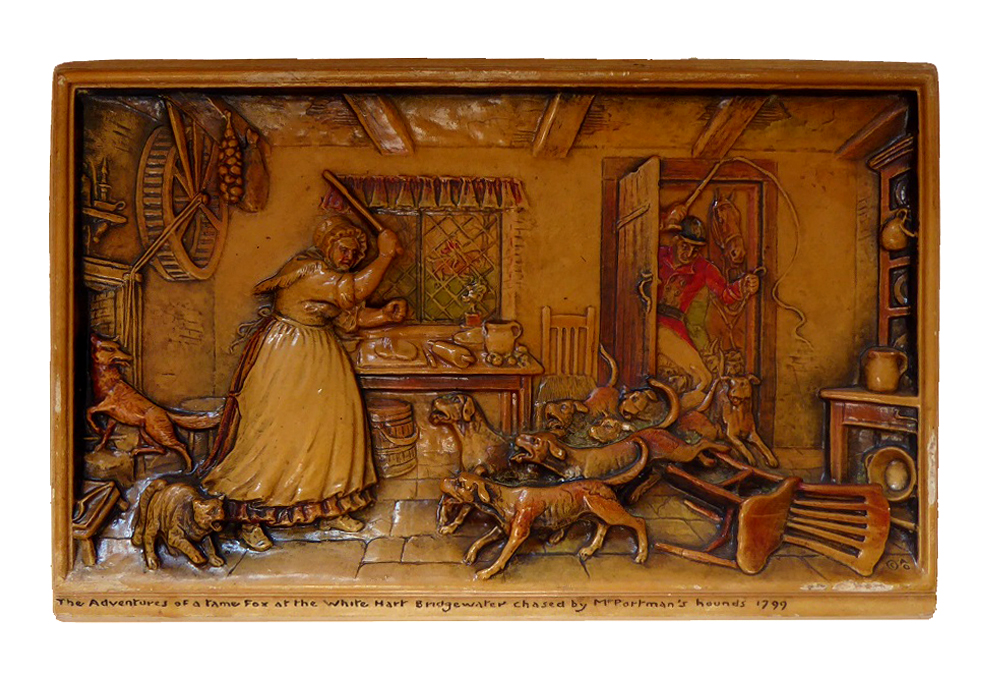
Ivorex was a sterine wax material used by the company of Arthur Osborne to make decorative plaques between 1899 and 1965. They created a three dimensional scene, which, when new, could make quite vivid scenes. Sadly the material tended to yellow over time, and the paint fade. Bizarrely, one of the scenes Osborne decided to depict relates to Bridgwater and is titles ‘The Adventures of a Tame Fox at the White Hart Bridgwater chased by Mr Portman’s Hounds 1799’.
The story it depicts seems to come from the Sporting Magazine of August 1799 (pp. 229-30) and runs as follows:
ANECDOTE OF A TAME FOX
MRS. Francis, of the White Hart Inn, Eastover-Street, near Bridgewater, in Somerset-shire, had a tame fox, brought up from a cub to run in the wheel as a turnspit. Reynard, one day, from neglect of the servant to make him fast, escaped his keeper, and taking to the Great Sedgmore, which was at that time covered with innumerable stocks of geese, presently went to work among the poultry, agreeable to his voracious fancy. The writer of this [account] was out the next morning with Mr. Portman’s dogs, and going towards Borough-bridge, found the glutton under Alfred’s-Tump. The dogs being laid on, Reynard presently passed the Parrot, and taking by North Petherton, sought the woods above Monkton; but being driven from thence, dashed through the Tone, a mile below Newton, and turning northward, passed Kingston, and was, for a time, lost in the thickets above Buncomb. The scent serving, Reynard was at length uncovered, mounted the Cutherstone hills, descended to Kenniton, and mounted the stone mountain in Lord Clifford’s park, from whence he was patiently driven by the staunch pack. Leaping the pales at Enmore, he took through Lord Egmont’s grounds, and getting again into his old track, re-crossed the Parrot just below Petherton; and taking slowly along the banks of the river, with the pack in full cry, leaped the fence of Mrs. Francis’s garden, and immediately entered the kitchen, and darted into the spit wheel, and began to perform his domestic office with as much unconcern, as if he had been placed there for that purpose. The fat cook, to whom Reynard was a great favourite, upon feeing the circumstance, and observing the dogs enter the house, spread the place of the fox’s retreat with her petticoats; at the same time beating off the eager hounds with all her might and main, to protect her old fellow servant; but this would have been impracticable, if the huntsman had not whipped them off; and after a chase of near thirty miles, left this unlicensed poulterer in the happy enjoyment of his less perilous habitation.
Sadly, the name of the contributor of this story is not named. It should be noted that Reynard was a very common way to refer to a fox, coming from the medieval stories of Reynard the Fox.
Some of the story can be corroborated. The landlords of the White Hart were Henry Francis c.1744 and William Francis c.1794-1798 (David Williams, Bridgwater Inns Past and Present, 1997). The White Hart was a coaching Inn and it sits partly on the site of the medieval hospital of St John founded in c.1200. The pub’s name is presumably a reference to King Richard II, although the first mention is in 1744. Either the Inn significantly predated this, or it was not uncommon for publicans to name Inns after ones where they had previously worked. In the nineteenth and presumably eighteenth century, it was meeting place for the town’s Tories, and there was a riot with the Whigs there in the 1850 (Squibbs’ History of Bridgwater, 1982). Although the White Hart is surrounded by urban development today, in 1799 there were open fields to the rear of the property.
So why was the original 1799 story turned into an Ivorex plaque at the start of the twentieth century? Hunting scenes seem to have been quite a popular theme for the company and the Bridgwater story seems to have been mildly popular through the nineteenth century. The Tame Fox story was repeated in a number of other local newspapers in 1799 itself, and then it was repeated by others over the next century, including the Western Gazette in 1868 Shepton Mallet Journal, West Somerset Free Press and the Dorset County Herald in 1875, the Grantham Journal and Manchester Evening News in 1883, In 1909 it appears again in the Field, and in 1924 in the Taunton Courier.
Oddly, this was not the only incident of a tame fox escaping in Eastover. On 21 January 1865 the West Somerset Free Press Reported:
AN IMPROVISED FOX-HUNT
A few mornings ago the inhabitants of our principal thoroughfares were treated to a fox-hunt at their doors. Mr Luxton, of Eastover, had kept a tame fox, but Reynard got out the yard and ran down Eastover. A hue and cry was raised, and all the curs [dogs] of the neighbourhood, accompanied by ‘rag-tag and bobtail’, were soon in hot pursuit. The fox went over the bridge, up Fore Street, across Cornhill, through York Buildings, to the back of the Clarence, down Angel Crescent, up North Gate, past the Union-house, and was finally bought to bay by a bull-dog, which seized him by the ear. His pursuers then came up, and he was placed in ignoble confinement in a sack, and carried back to his old quarters.
MKP 12 October 2019 –with thanks to Alasdair A. MacDonald for prompting the search on Tame Fox at the White Hart.
